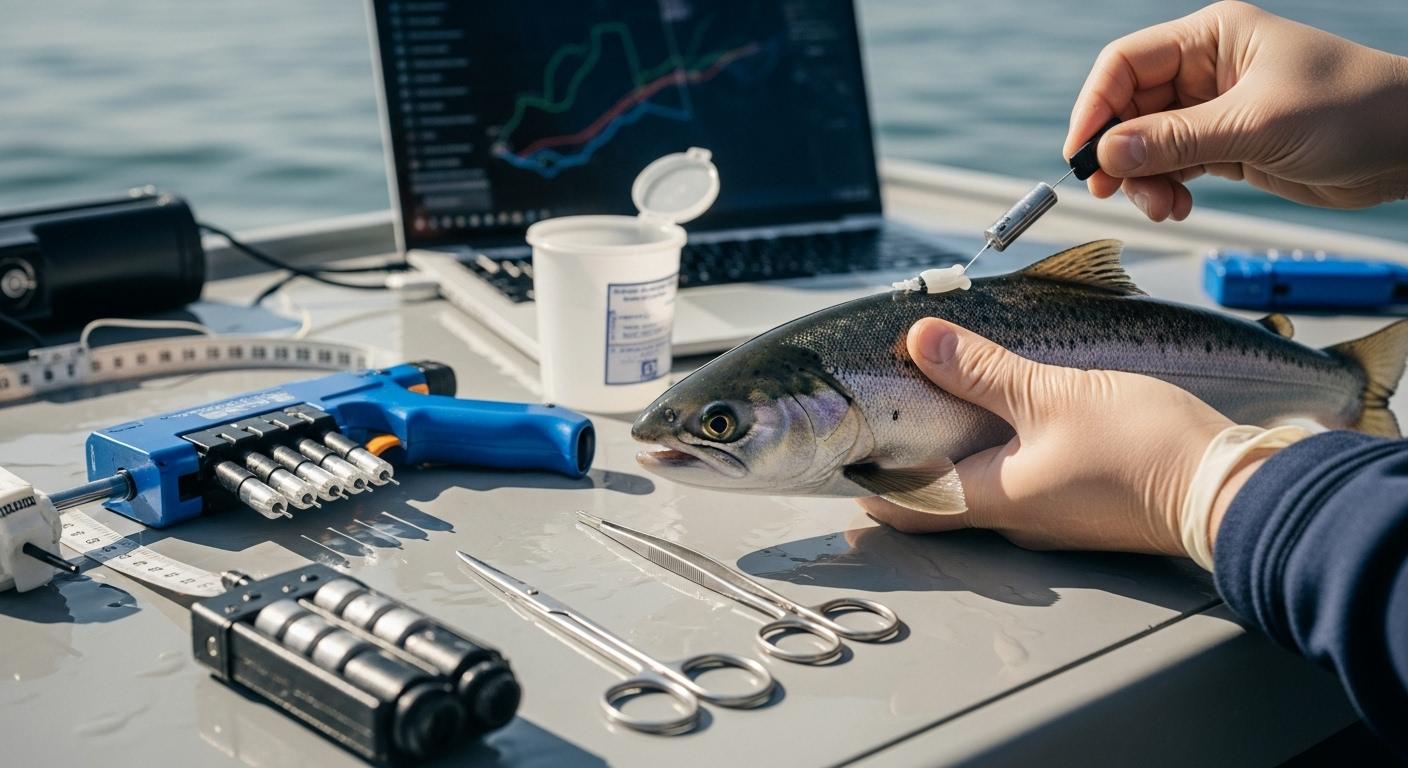Advancements in Smart Fish Tagging Solutions for Monitoring & Tracking

Advancements in Monitoring and Tracking Through Smart Fish Tagging Solutions
The intersection of marine biology and advanced technology has ushered in an era of unprecedented capability in aquatic research. Fish tagging has evolved far beyond simple identification markers, transforming into sophisticated monitoring platforms that provide multidimensional insights into fish behavior, physiology, and environmental interactions. These smart tagging solutions leverage miniaturized sensors, wireless communication networks, artificial intelligence, and cloud computing to create comprehensive monitoring systems that are revolutionizing our understanding of aquatic ecosystems and reshaping conservation strategies worldwide.
The Evolution from Passive to Smart Tagging Systems
Traditional tagging methods served primarily as identification tools, enabling researchers to track individual fish movements through physical recapture or visual resighting. The paradigm shift toward smart fish tagging represents a fundamental transformation in research capabilities, converting simple markers into active data collection platforms.
Modern smart tags integrate multiple sensor arrays within compact, biocompatible packages. A single tag might simultaneously monitor depth, water temperature, ambient light levels, acceleration patterns, and even dissolved oxygen concentrations. The integration of onboard data processors allows these devices to analyze information in real-time, making intelligent decisions about data storage and transmission priorities.
Research conducted by the Schmidt Ocean Institute demonstrates this technological leap. Their smart tagging program deployed on Pacific bluefin tuna incorporated tri-axial accelerometers, pressure sensors, temperature probes, and light detectors within tags weighing less than 40 grams. Over 18-month deployment periods, these devices recorded over 2 million data points per individual fish, creating extraordinarily detailed behavioral profiles previously impossible to obtain.
Miniaturization and Battery Technology Breakthroughs
Perhaps the most significant advancement enabling smart fish tagging lies in component miniaturization and energy efficiency improvements. Moore's Law—the observation that computing power doubles approximately every two years—has directly benefited aquatic telemetry, allowing increasingly sophisticated capabilities in progressively smaller packages.
Contemporary acoustic transmitters suitable for fish weighing as little as 10 grams now incorporate capabilities that required 200-gram tags just a decade ago. This miniaturization expands the range of species amenable to electronic monitoring, bringing previously untraceable organisms into research scope. Studies on juvenile salmon, traditionally difficult to track due to their small size, now employ tags weighing under 0.5 grams that transmit for six months.
Battery technology represents another crucial breakthrough. Lithium-polymer batteries deliver higher energy density while maintaining stable performance across temperature fluctuations common in aquatic environments. Advanced power management systems extend operational lifespans by intelligently cycling between active sensing, data processing, and low-power sleep modes. Some emerging designs incorporate energy harvesting mechanisms that capture kinetic energy from fish swimming movements, potentially enabling indefinite tag operation.
Real-Time Data Transmission and Connectivity
The transition from archival tags requiring physical recapture to devices capable of real-time data transmission fundamentally changes research timescales. Rather than waiting months or years for recapture events, researchers now access current data enabling adaptive management responses to emerging situations.
Cellular-enabled surfacing tags exemplify this capability. Deployed primarily on large pelagic species, these devices periodically transmit stored data when fish surface and tags break the water-air interface. Projects tracking mako sharks in the North Atlantic receive daily position updates and diving profiles, allowing researchers to observe behavior patterns as they develop rather than reconstructing them retrospectively.
The integration of fish tagging systems with Internet of Things (IoT) infrastructure creates seamless data pipelines from tagged individuals to centralized databases. Fixed receiver stations equipped with satellite or cellular uplinks automatically relay detection data to cloud servers within minutes of recording. The Great Lakes Acoustic Telemetry Observation System exemplifies this approach, with over 500 receivers across five lakes transmitting data continuously to central repositories accessible to authorized researchers worldwide.
Multi-Sensor Integration and Environmental Context
Understanding fish behavior requires contextualizing movements within environmental conditions. Smart tags increasingly incorporate diverse sensor arrays that record not just where fish go but the environmental parameters they experience throughout their travels.
Temperature and depth sensors form the foundation of most multi-sensor tags, revealing vertical habitat use patterns and thermal preferences. Studies employing these sensors discovered that yellowfin tuna in tropical waters perform regular deep dives to depths exceeding 1,000 meters, exposing themselves to water temperatures below 5°C despite surface temperatures near 28°C. This thermoregulatory diving likely serves multiple purposes including parasite removal and access to deep-dwelling prey.
Accelerometer integration adds behavioral context impossible to obtain through position data alone. Three-axis accelerometers record body orientation and movement patterns at sampling rates up to 100 Hz, enabling researchers to distinguish between swimming, resting, and feeding activities. Machine learning algorithms trained on accelerometer signatures can automatically classify behaviors, processing vast datasets that would require impossible amounts of manual analysis.
Recent innovations include dissolved oxygen sensors revealing hypoxia exposure. Research in the Baltic Sea using oxygen-sensing tags found that cod actively avoided water masses with oxygen concentrations below 2 mg/L, even when these areas contained high prey densities. This finding explains observed shifts in cod distribution and has direct implications for predicting climate change impacts as warming waters expand hypoxic zones.
Artificial Intelligence and Pattern Recognition
The massive datasets generated by smart fish tagging systems overwhelm traditional analysis methods. Artificial intelligence and machine learning algorithms now play central roles in extracting meaningful patterns from complex, high-dimensional telemetry data.
Neural networks trained on tagged fish movements can predict future locations with remarkable accuracy. Research applying deep learning to acoustic telemetry data achieved 85% accuracy in predicting individual fish positions 24 hours in advance, enabling proactive fisheries closures protecting spawning aggregations. These predictive models account for environmental variables, historical movement patterns, and individual behavioral characteristics, creating sophisticated forecasts impossible through conventional statistical approaches.
Anomaly detection algorithms identify unusual behavioral patterns suggesting stress, disease, or predation risk. By establishing baseline activity profiles for tagged individuals, machine learning systems flag deviations potentially indicating health problems or environmental disturbance. Early warning systems built on this capability detected fish kills from pollution events up to 48 hours before conventional monitoring methods, allowing emergency response teams to implement mitigation measures.
Biotelemetry and Physiological Monitoring
The frontier of smart fish tagging extends beyond tracking movements to monitoring internal physiological states. Biotelemetry tags equipped with biosensors measure parameters like heart rate, muscle activity, and even blood chemistry, providing windows into fish physiology during natural behaviors.
Electromyography sensors embedded in smart tags record electrical signals from swimming muscles, quantifying metabolic effort. Comparative studies revealed that sockeye salmon migrating through dam fish ladders expended 40% more energy than fish navigating natural rapids of equivalent elevation gain. This quantitative evidence informed dam modification projects that reduced passage energy costs, improving migration success rates.
Heart rate monitoring via electrocardiogram sensors reveals stress responses and metabolic demands. Research on Atlantic salmon equipped with ECG tags demonstrated that fish encountering warm water temperatures above 22°C exhibited elevated heart rates persisting for hours after exposure, suggesting prolonged physiological stress. These findings establish thermal thresholds for fisheries regulations, protecting vulnerable populations during heat waves.
Integrated Acoustic Networks and Collaborative Research
The establishment of continental-scale acoustic telemetry networks represents a paradigm shift in collaborative fisheries research. Individual research groups traditionally operated isolated receiver arrays, limiting geographic scope. Coordinated networks now enable basin-wide and even ocean-scale tracking studies previously inconceivable.
The Atlantic Cooperative Telemetry Network connects over 1,000 acoustic receivers from Canada's Bay of Fundy to Florida's Keys, creating a continuous monitoring corridor along the entire Atlantic seaboard. Tagged fish moving through this array generate detection histories revealing migration patterns, residency periods, and habitat connectivity at unprecedented scales. A single striped bass tagged in Maryland's Chesapeake Bay was subsequently detected at 47 different receiver stations spanning 2,400 kilometers of coastline over three years.
Data sharing protocols enable researchers to access detections of their tagged fish recorded on others' receivers, multiplying effective monitoring coverage without proportional cost increases. The Fish Tracking Database maintained by the Ocean Tracking Network archives over 250 million fish detections from global collaborative networks, creating an invaluable resource for meta-analyses and comparative studies.
Mobile Applications and Citizen Science Integration
Democratization of fish tagging data through mobile applications engages broader communities in research and conservation. Smart phone apps allow recreational anglers to report tagged fish captures, dramatically increasing recapture reporting rates compared to traditional mail-in card systems.
The iAngler application developed by the Atlantic States Marine Fisheries Commission illustrates this approach. Anglers photograph tagged fish and submit observations through the app, which automatically extracts tag identification codes via optical character recognition. The system transmitted over 15,000 tag reports in its first two years, tripling reporting rates compared to previous paper-based systems.
Some programs provide real-time feedback to citizen scientists, displaying migration maps showing where their tagged fish traveled. This engagement transforms casual participants into invested stakeholders, strengthening public support for conservation initiatives. Educational components within apps explain research objectives and conservation challenges, fostering ocean literacy among user communities.
Environmental DNA Integration with Tagging Data
An emerging frontier combines smart fish tagging with environmental DNA (eDNA) analysis, creating complementary monitoring systems that validate and enhance each other. eDNA sampling detects species presence through genetic material shed into water, while tagged fish provide ground-truth data confirming species identifications and abundance estimates.
Pilot studies integrating these approaches achieved detection sensitivities exceeding either method alone. eDNA sampling identified species presence at sites where tagged fish were later detected, validating molecular detection accuracy. Conversely, tags revealed species presence at locations where eDNA sampling failed, highlighting limitations of molecular methods in high-flow environments where genetic material disperses rapidly.
Challenges and Future Innovations
Despite remarkable progress, smart fish tagging faces ongoing challenges. Tag size relative to fish body mass remains limiting for small species. Power consumption constrains sensor sampling rates and transmission frequencies. Biofouling on external sensors can degrade measurement accuracy over extended deployments.
Future innovations will likely address these constraints through continued miniaturization, energy harvesting technologies, and anti-fouling coatings. Bioabsorbable tags that dissolve after predetermined periods eliminate long-term impacts on tagged individuals. Optogenetic sensors using light-sensitive proteins might enable entirely new physiological measurements.
Conclusion
The rapid advancement of smart fish tagging solutions represents a transformative moment in aquatic research. By converting simple identification devices into sophisticated environmental and physiological monitoring platforms, these technologies provide unprecedented insights into fish ecology, behavior, and conservation needs. The integration of multi-sensor arrays, real-time data transmission, artificial intelligence analytics, and collaborative networks creates research capabilities that would have seemed like science fiction mere decades ago. As these technologies continue evolving and costs decline, their application will expand across broader ranges of species and ecosystems, strengthening humanity's capacity to understand and sustainably manage aquatic resources in an era of accelerating environmental change.





